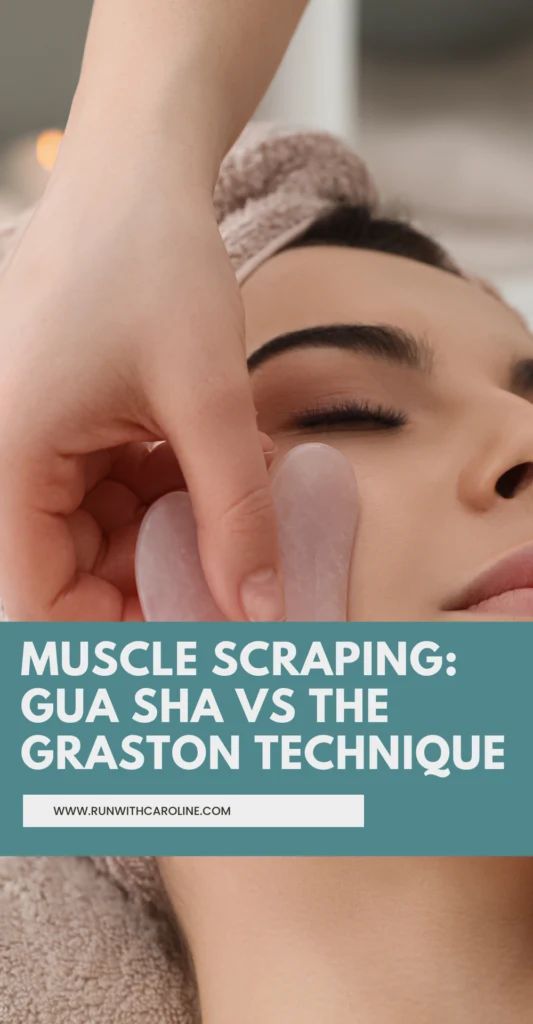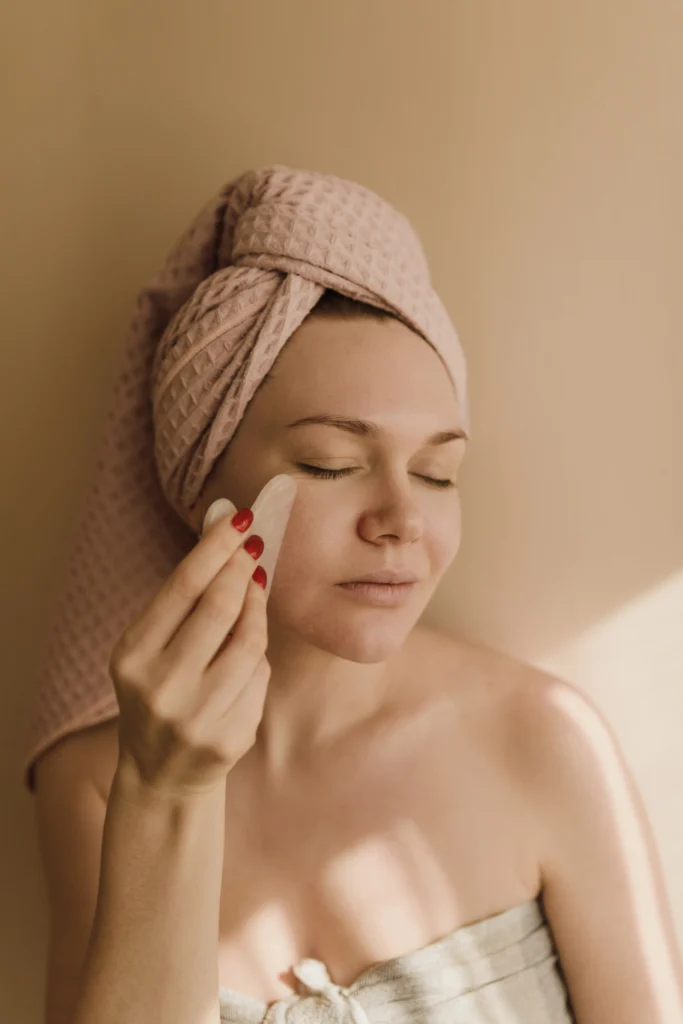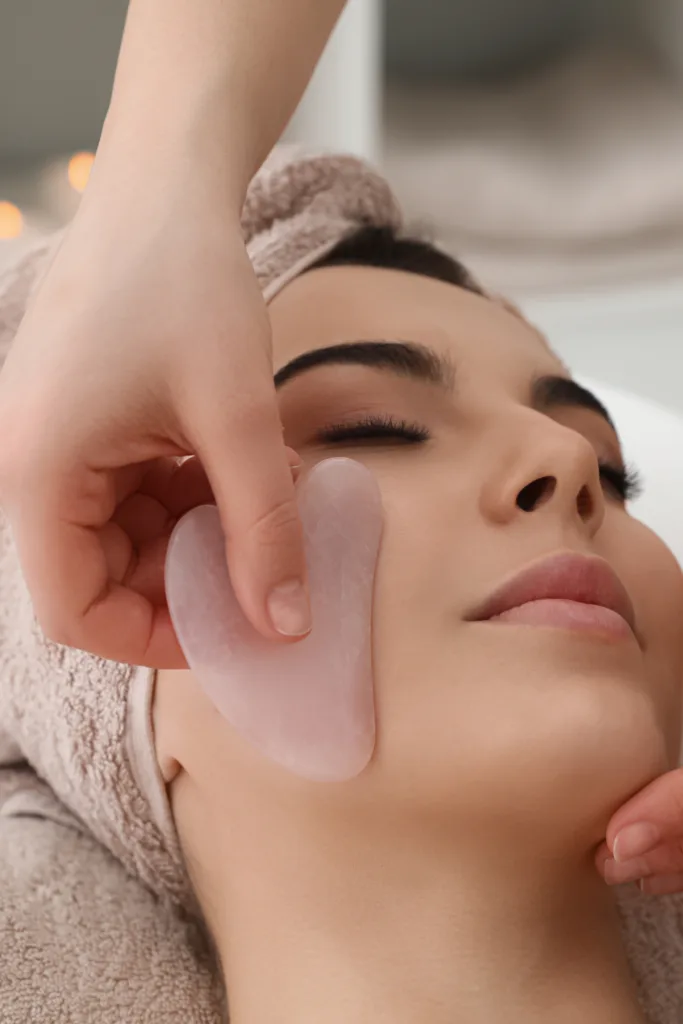Muscle scraping sounds painful, but in fact it’s a form of therapy that has been used for centuries to promote healing of the muscles, fascia and tendons.
Also known as Gua Sha, muscle scraping is widely practiced in Chinese medicine and has become popularised in western culture over the last few years to promote healing.
We’ll also explore:
- What is muscle scraping?
- What does muscle scraping do?
- Is muscle scraping painful?
- Is muscle scraping safe?
- Who should avoid muscle scraping?
- How to do muscle scraping at home
Ready?
Let’s go!

What is muscle scraping?
Muscle scraping is a form of physical stimulating therapy that is thought to accelerate the healing of muscles, tendons and fascia.
Also referred to as instrument-assisted soft tissue mobilisation (IASTM), muscle scraping developed along with other physical therapies such as acupuncture, massage and cupping.
Also known as skin scraping, Gua Sha is a tradition widely practiced in China and Southeast Asia.
Gua Sha involves the use of a smooth-edged instrument that is gently dragged on the surface of the skin to help break up scar tissue and adhesions.
It is often used to treat myalgia (muscle aches and pains), chronic pain and other muscle issues, and is performed according to the location of acupuncture points along meridians in the body.
In Chinese medicine, these meridians are the main pathways that transport qi (energy) and xue (blood) throughout the body.
Gua Sha roughly translates into English as “dredging meridian stagnation”.
Many diseases and health issues can be traced back to stagnant energy and blood in the body.
Gua Sha is believed to encourage a healthy flow of energy and blood in the body.
The process also stimulates lymphatic flow and drainage (your body’s natural detoxification system), releasing excess fluids that are stuck beneath the surface of the skin.
Related: How to start running again after an injury: 5 tips for success
What does muscle scraping do?
Muscle scraping has a number of reported benefits.
#1 Inhibits pain
According to a 2012 study, muscle scraping has pain-relieving effects on myalgia (muscle aches and pain) and chronic pain.
Other studies have pointed to the fact that muscle scraping can induce a placebo effect, which can contribute to positive effects for symptom relief.
#2 Enhances blood circulation
Studies have shown that muscle scraping helps to enhance blood circulation in the body.
Other research has found that scraping significantly improves the blood perfusion volume.
Adding that muscle scraping increases the temperature in the scraping area, promoting the local blood circulation and energy metabolism.
These in turn promote better blood flow which supports faster healing.
#3 Activates nerve fibres
There are neurological benefits to muscle scraping, as well as physical.
Research tells us that the skin, the nervous system and immune system interact with one another and generate physiological responses to scraping, which may result in therapeutic benefits.
When soft tissues are mobilised, certain nerve fibres are activated.
The body’s sense organs, which are important for movement (such as proprioceptors) respond to this treatment.
#4 Breaks down scar tissue
Muscle scraping breaks down the scar tissue that is normally associated with some form of trauma to the soft tissue (e.g. a pulled muscle, ligament, tendon or fascia).
This in turn can help to alleviate pain and lessen any restricted movement.
#5 Relieves muscle spasms
Muscle spasms (also called muscle cramps) occur when your muscle involuntarily and forcibly contracts uncontrollably and can’t relax.
Spasms are common and can affect any of your muscles – either all or part of a muscle, or several muscles.
One 2012 study concluded that muscle scraping helps to relieve muscular spasm and improve the metabolism of tissues.
Adding that the increased temperature and microcirculation could reversely remove the microcirculatory obstruction, especially for spasm.
#6 Combats inflammation
Inflammation is your body’s natural response to an injury, illness or in some cases autoimmune disease.
Research tells us that long term inflammation can present complications such as chronic fatigue, chronic pain, weight gain and weight loss, frequent infections and mood disorders.
Cytokines are small proteins in the body that affect the growth of all blood cells and other cells that help the body’s immune and inflammation responses.
One 2021 study found that muscle scraping causes a downregulation of proinflammatory cytokine production, resulting in anti-inflammatory and antinociceptive effects.
Adding that in an animal-based study, after three treatment courses of muscle scraping the levels of inflammatory cytokines decreased dramatically.
Related: What does running do for your body? 10 benefits of running

Related: Can you exercise after Botox? 9 do’s and don’ts for Botox aftercare
How long will it take to see benefits from muscle scraping?
You can expect to see results within one week by doing Gua Sha.
However, treatment times will very much depend on the type of issue that you have.
It’s worth noting that muscle scraping won’t work for everyone.
If you don’t experience any relief from pain or tightness after three weeks, or 5 sessions of muscle scraping, it is recommended you stop the treatment.
Related: How to fix a saggy butt: 5 exercises to lift your butt
Is muscle scraping painful?
When performed properly by a certified practitioner, muscle scraping can have a positive stimulation and physiological response on the skin.
It can change the colour of your skin – causing it to warm and redden.
Scraping marks (known as petechiae or blood spots) build up in the scraped area and produce warming of the skin or even slight pain.
Generally, however, muscle scraping is tolerable in terms of pain intensity.
Related: 6 tips for dealing with sore muscles after running
Is muscle scraping safe?
Muscle scraping is generally considered safe when under the guidance of a certified practitioner.
Related: How to use Jeff Galloway’s magic mile running test

Who should avoid muscle scraping?
Despite its benefits, muscle scraping isn’t recommended for everyone.
You should avoid muscle scraping if:
- You’ve had surgery in the last six weeks.
- You’re taking blood thinners or have a blood clotting disorder (since muscle scraping promotes blood circulation).
- You have deep vein thrombosis.
- You have a rash or sunburn.
- You have an infection or wound that has not fully healed.
- You make use of an implant, such as a pacemaker or internal defibrillator.
Related: Pulse squats + 12 squat variations to try before your next run
How to do muscle scraping at home
Here’s how to perform Gua Sha at home.
The Graston Technique must be performed by a qualified clinician because it requires training to be able to perform properly.
You can find clinicians trained in the technique on the Graston Technique website.
#1 Choose a scraping tool
Jade, Rose Quartz and metal Gua Sha tools are also readily available in most wellness stores.
#2 Apply a light oil or cream
Apply a light oil or cream so the Gua Sha tool can move easily across the skin, without tugging at your skin.
#3 Begin from the midline with light pressure then go outwards
Start from your body’s midline with light pressure and then outwards laterally to drain lymph.
For each these movements, do not go back and forth, only lateral to the sides of the body and face.
- On your chest, drag the tool gently towards your armpit, working from the bottom of the chest up.
- On the sides of your neck, drag the tool gently, beginning at the midline of the neck, going to the upper tip of the jaw along the sides.
- On the cheek bone, drag the tool from the midline at the side of your nose, moving to the side of your face.
- On the brow bone, sweep up to the hairline and then out to the sides of the head.
- Repeat 3 to 7 times for each area.
- Make sure you do both sides of the body and face.
- Use the smaller side of the tool to work very gently around the eyes, nose, and mouth, moving always to the sides of the face.
Related: What muscles does running work? 5 ways to prevent common running injuries
- 5 things I wish I’d known before returning to running - March 3, 2024
- Running 20 minutes a day: Benefits + how to start - January 27, 2024
- How to run your first 2 hour half marathon - January 16, 2024
